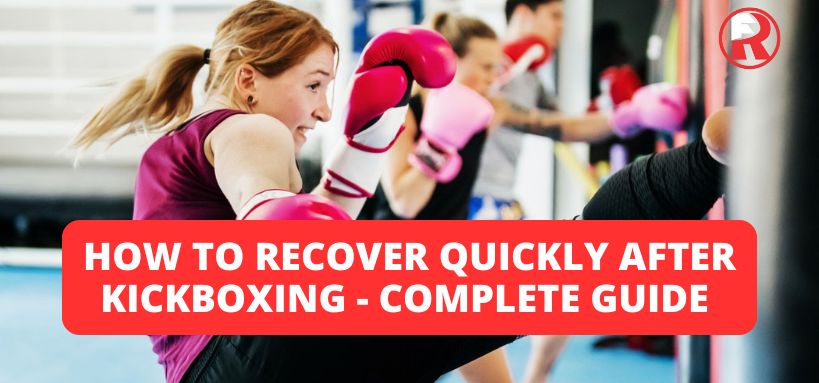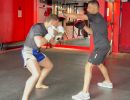Whether you train for fitness, self-defense, or competition, kickboxing pushes your body to its limits. The intense punches, kicks, and cardio bursts challenge your muscles, joints, and stamina. But what you do after training can be just as important as the workout itself. Proper recovery after kickboxing helps your body repair, grow stronger, and stay injury-free. Without it, you risk constant soreness, fatigue, and burnout.
This ultimate guide will teach you best practices for physical, nutritional, and mental recovery. From post-training meals to sleep strategies, we’ll cover everything you need to keep performing at your peak.
1. Why Recovery After Kickboxing Is So Important
Kickboxing is a high-impact sport involving fast, explosive movements. This intensity causes:
- Micro-tears in muscles – leading to soreness and growth potential
- Joint strain – especially in knees, hips, and shoulders
- High energy expenditure – depleting glycogen stores
- Nervous system fatigue – affecting reaction time and coordination
Good recovery after kickboxing ensures:
- Muscle repair and growth – stronger and more resilient over time.
- Reduced soreness – so you can train more frequently.
- Better energy levels – no dragging yourself to the next class.
- Injury prevention – stronger muscles and joints handle impact better.
- Improved mental focus – because your brain recovers too.
2. Immediate Post-Workout Recovery (First 60 Minutes)
The first hour after training is the “golden window” for recovery. Your body is primed to absorb nutrients, rehydrate, and repair.
a) Hydrate Smart
- Drink 500–750ml of water immediately.
- Add an electrolyte drink if you sweated heavily.
b) Refuel with a Balanced Snack
Aim for a 3:1 ratio of carbs to protein:
- Examples: banana + protein shake, chicken wrap, or yogurt with berries.
c) Cool Down & Stretch
- Spend 5–10 minutes cooling down with light walking or jogging in place.
- Stretch hamstrings, quads, shoulders, and calves to prevent stiffness.
d) Use a Foam Roller
- Roll major muscle groups for 30–60 seconds each.
- Focus on quads, glutes, and calves to reduce lactic acid buildup.
3. Short-Term Recovery (0–48 Hours)
These steps keep soreness low and energy high after a tough kickboxing session.
Prioritize Sleep
- Sleep 7–9 hours to allow muscle repair and hormone balance.
- Keep your bedroom cool and dark to improve sleep quality.
Eat Recovery Meals
Your meals should include:
- Protein (chicken, fish, tofu, eggs) for muscle repair.
- Complex carbs (brown rice, sweet potato) to restore energy.
- Healthy fats (avocado, nuts) for joint health.
Active Recovery
- Go for a walk, cycle slowly, or do light yoga.
- Movement improves blood flow without straining muscles.
Cold & Heat Therapy
- Ice packs reduce inflammation within 24 hours.
- Heat packs or baths relax muscles the next day.
Compression Clothing
- Compression sleeves can help improve circulation and reduce swelling.
4. Long-Term Recovery Habits for Kickboxers
If you train multiple times a week, long-term recovery is just as important as short-term.
- Schedule Rest Days – at least 1–2 per week.
- Cross-Train – swimming, cycling, or weightlifting to work different muscles.
- Mobility Training – yoga or Pilates keeps you flexible and reduces injury risk.
- Nutrition Tracking – make sure you’re getting enough protein and calories.
- Monitor Progress – track energy, soreness, and performance to avoid overtraining.
5. Common Recovery Mistakes to Avoid
Even experienced fighters can harm their recovery by making these errors:
- Skipping Meals After Training – delays muscle repair.
- Overtraining Without Rest – increases injury risk.
- Poor Sleep Habits – slows recovery and mental sharpness.
- Not Listening to Your Body – training through pain can lead to serious injury.
- Neglecting Mental Recovery – stress management is key for performance.
6. Recovery After Kickboxing for Beginners vs. Pros
Beginners often need more rest days and lighter recovery activities like walking or stretching.
Professional fighters may use advanced techniques like cryotherapy, deep-tissue massage, and specialized recovery supplements.
7. Advanced Recovery Methods
- Cryotherapy – extreme cold to reduce inflammation.
- Sports Massage – relieves tension and improves mobility.
- Contrast Baths – alternating hot and cold water boosts circulation.
- Supplements – BCAAs, creatine, and omega-3s can support recovery.
8. Mental Recovery After Kickboxing
Physical recovery means nothing if your mind is stressed and unfocused.
- Practice meditation or breathing exercises.
- Spend time doing hobbies you enjoy.
- Take mental rest days just like physical rest days.
9. Recovery Nutrition Plan Example
| Time After Training | Meal/Snack Ideas | Purpose |
|---|---|---|
| 0–30 minutes | Banana + protein shake | Quick fuel, muscle repair |
| 2 hours | Chicken with sweet potato | Energy restoration |
| Dinner | Salmon with quinoa and vegetables | Joint health, recovery |
| Evening Snack | Greek yogurt with berries | Slow protein release overnight |
Also Read: Kickboxer’s Diet: What to Eat Before and After Training for Best Performance
10. Frequently Asked Questions
Q: How many rest days should I take after kickboxing?
A: Beginners should aim for 2–3 rest or active recovery days per week.
Q: Can I train every day if I recover properly?
A: Advanced athletes can, but it’s not recommended for beginners due to injury risk.
Q: What’s the best drink for recovery after kickboxing?
A: Water is essential, but adding electrolytes helps if you sweat a lot.
Q: Does stretching really help recovery?
A: Yes—stretching improves blood flow and prevents stiffness.
Q: Can I speed up recovery naturally?
A: Yes, by eating nutrient-rich foods, sleeping well, and staying hydrated.
Conclusion
Kickboxing is an incredible way to build strength, speed, and endurance—but without proper recovery, you won’t reach your full potential. Mastering recovery after kickboxing means giving your body the hydration, nutrition, rest, and movement it needs to rebuild stronger. Whether you’re training for fun or preparing for competition, make recovery a core part of your routine—and you’ll see better results, fewer injuries, and more enjoyment in every session.
Join Final Round kickboxing Fitness Gym for Best Kickboxing Classes.





